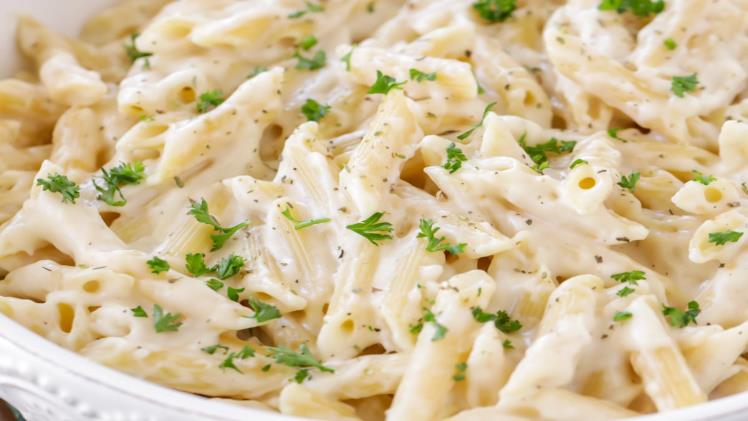Creamy and indulgent, a perfectly executed white sauce can elevate a simple bowl of pasta to gourmet status. This versatile sauce, often referred to as béchamel sauce, forms the basis for a myriad of dishes and is surprisingly easy to make. In this article, we’ll guide you through the process of making a delicious white sauce for pasta, unlocking the secrets to mastering this culinary essential.
Ingredients:
Before you begin, gather the following ingredients for your white sauce:
Butter: Typically, you’ll need around 4 tablespoons of butter. Butter adds richness and flavor to the sauce.
All-Purpose Flour: You’ll require roughly 4 tablespoons of all-purpose flour. The flour acts as a thickening agent.
Milk: Approximately 2 cups of milk. Whole milk works best for a creamy texture, but you can use low-fat or plant-based alternatives.
Salt: To taste, a pinch of salt.
Pepper: Freshly ground black pepper to taste. It adds a subtle kick to the sauce.
Optional Extras: Nutmeg, grated Parmesan cheese, and garlic can be used for added flavor if desired.
Steps to Make White Sauce for Pasta:
- Gather Your Equipment:
For making white sauce, you’ll need a medium-sized saucepan, a whisk, a wooden spoon, and measuring cups and spoons. Having these items ready before you start cooking will make the process smoother.
- Start with a Roux:
The foundation of white sauce is the roux, a mixture of equal parts butter and flour. Melt the butter in your saucepan over medium heat. Allow it to sizzle but not brown. When it’s fully melted, add the flour all at once.
- Whisk Vigorously:
As soon as the flour is added to the melted butter, start whisking vigorously. The goal is to combine the flour and butter into a smooth paste with no lumps. Keep whisking for 2-3 minutes, ensuring that the roux doesn’t take on any color. This will help eliminate the raw flour taste from your sauce.
- Gradually Add Milk:
Now, it’s time to transform your roux into a creamy sauce. Slowly pour in the milk while continuing to whisk. It’s important to add the milk gradually, whisking constantly to avoid lumps. The mixture will thicken as the milk incorporates.
- Simmer and Season:
Once you’ve added all the milk and the sauce is smooth, let it simmer over low to medium heat. Stir with a wooden spoon and allow it to thicken. This can take about 5-10 minutes. Don’t forget to scrape the sides and bottom of the pan to prevent sticking.
- Season the Sauce:
Season your white sauce with a pinch of salt and freshly ground black pepper. You can also add a touch of freshly grated nutmeg or minced garlic at this point if you desire extra flavor. Taste and adjust the seasonings to your preference.
- Customize Your Sauce:
White sauce serves as a wonderful canvas for creativity. To make it even more delightful for your pasta, consider adding some grated Parmesan cheese for a cheesy twist or fresh herbs like chopped parsley or basil for a burst of freshness.
- Mix with Cooked Pasta:
Your white sauce is now ready to be combined with your cooked pasta. Pour the sauce over your drained pasta and toss until each strand or piece is coated with the velvety white goodness. The heat of the pasta will help the sauce meld perfectly.
- Garnish and Serve:
Before serving, garnish your pasta dish with extra Parmesan cheese, a sprinkle of fresh herbs, or even a drizzle of olive oil. A final grind of black pepper adds an attractive touch.
Tips and Tricks for a Perfect White Sauce:
Consistency is Key: The thickness of your sauce can be adjusted by controlling the amount of milk and the cooking time. For a thinner sauce, use more milk, and for a thicker sauce, simmer for longer.
Low and Slow: Keep the heat low when simmering your sauce to avoid scorching it. Stir consistently to prevent clumps.
Use Freshly Grated Nutmeg: If you decide to add nutmeg, always use freshly grated nutmeg for a more aromatic and intense flavor.
Variations: Feel free to experiment with different cheeses, such as Gruyère or cheddar, to create a cheese sauce. You can also add sautéed mushrooms, spinach, or sun-dried tomatoes for a unique twist.
Don’t Rush the Roux: Take your time when making the roux. Rushing this step can result in a lumpy or floury-tasting sauce.
White sauce for pasta is a classic that never goes out of style. Once you master this basic technique, you can use it as a base for a variety of dishes, including mac and cheese, lasagna, and casseroles. So, don your chef’s hat, grab your ingredients, and start creating a creamy, dreamy pasta dish that will leave your taste buds dancing with delight.

